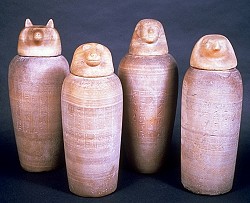
The name for the jars and boxes that contained the mummified internal organs. The jars usually have lids in the form of the heads of the Four Sons of Horus: Amset, Duamutef, Hepi and Qebehsenuf. These gods protected the internal organs (the liver, stomach, lungs and intestines, respectively) and were in turn protected by four goddesses (Isis, Neith, Nephthys and Selkis), who were also associated with the four cardinal points (south, east, north and west, respectively). Preserving the internal organs during mummification is first attested in the case of Queen Hetepheres, the wife of Seneferu and the mother of Khufu. An alabaster chest was found in her tomb, divided into four compartments. In three of them were the remains of her internal organs preserved in natron; dried organic material was found in the fourth compartment. The word 'canopic' is derived from the name of the Greek sailor Canopus, who was allegedly buried in Canopus (Abuqir) in the Delta and who was worshipped in the Graeco-Roman Period in the form of a jar with a human head. Although the 'jar' in Canopus was in the shape of the god Osiris and was not linked to the internal organs, the name has nevertheless passed into general use.